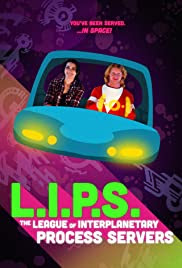Text © Richard
Gary / Indie Horror Films, 2021
Images from
the Internet
Lake Michigan
Monster
Directed by Ryland
Brickson Cole Tews
Arrow Video; MVD Entertainment
78 minutes, 2020
www.arrowfilms.com
www.facebook.com/lakemichiganmonster
www.facebook.com/ArrowVideo/
www.mvdb2b.com
Let me start off by saying that I am straight-edge, and have been longer than the age of many people who are reading this. My history with drugs is I smoked pot about a dozen times in my teen years, and tried coke once when I was 22. Never really a drinker, I probably had the equivalent of a six-pack or two a year. I don’t really like the taste or feel of alcohol, so I gave them up, too. The reason I bring this up is because this film is a trip-and-a-half.
 |
| Beulah Peters, Ryland Tews, Daniel Long, Erick West |
Almost like a Terry Gilliam fever dream, we are introduced to Capt. Seafield (director Ryland Brickson Cole Tews) who explains that his dear ole dad was killed by the titular creature, and gathers a crew together to find and kill it. There is snarky weapons expert Sean Shaughnessy (Erick West, Ryland’s friend), Sonar “individual” Nedge Pepsi (Beulah Peters, Ryland’s girlfriend), and former Naval Officer Dick Flynn (Daniel Long, Ryland’s childhood friend), or as Seafield calls them, “The Team of the Century.”
There is more to the cast, but many of them are actually related to the director, such as his father playing his pirate-clad brother Ashcroft (Wayne Tews, who wrote and sang the theme song, and also created a lot of the cool props), and his 87-year-old grandmother playing his wife, Martha (Lucille Tews). The cool-yet-chincey-in-a-good-way looking sea hag monster is played by the director, Ryland, that looks a bit like the titular The She-Creature (1956).
Of course, things don’t go as planned, as if there were a real plan, though that not-real plan gets played out more than once, leading to a mutiny of sorts. I will not give away much of the story, such as it is, and will instead revel in its insanity. Through what looks like it may be Paper Mache masks, scenery and monsters, along with the graphics, Tews’ vision is brought to life, in its own twisted world within our world.
There are some amazing set pieces, mostly either on or under the water, in Milwaukee (beer plays a key role in this, as should be, as beer could be what made Milwaukee famous), the North Point Light Station (lighthouse), or on the Lake X-press ferry. The whole third act’s setting is ridiculous at best, which is part of what makes its charm.
The film is shot in contrasty and grainy black and white with “film scratches” added in to “age” it. Even so, there is a lot of animation work going on; when it was filmed it was with a green screen to add texture and said computer graphics.
There are three ways to watch this film. The first is get shitfaced and to just mock it like you’re on “Mystery Science Theater 3000”; have a blast! The second is to see it straight, pay attention to the humor and catch the lines the stoners are bound to miss, and feel righteously smug (my category). Third is to just think it’s a stupid mess and turn it off after five minutes as you would with the likes of Monty Python and complain that “SNL” hasn’t been funny since John Belushi left.
Perhaps this is the evil plan for the first feature film for the four-named director to take over the world, by using a cast whose first acting credit is as a member of the Team of the Century. Sort of a human version of Python’s “Confuse a Cat” sketch. For me, I found it quite amusing, knowing I would be watching it again to dig for the jokes I missed, and I’m guessing there are a few. There are some influences here and there, some discussed during a commentary, such as Guy Maddin, and there is a bit of the good Capt. playing checkers with a ghost a la Ingmar Bergman’s The Seventh Seal (1957).
The Blu-ray is heavily loaded with bonus materials, as is wont with Arrow Video. It starts with three commentaries: two with the cast and crew (same group, but one while sober, the other drunk) featuring writer/director/actor Ryland Tews and actors Daniel Long, Beulah Peters, Erick West and editor Mike Cheslik. For the sober one, the group is self-depreciating while being informative and quite fun with each other; it is easy to tell they got along quite well, even as they sling insults around. There is a bit of talking over each other, but mostly it works and worth a listen. The “drunk” one is recorded the same day, so there is not much more info, and yes, they are drunk, but not sloppily so. Surprisingly, it remains somewhat amusing thanks to their camaraderie. Honestly (and I will always be honest with all youse), I was planning on seeing about half of it, but ended up watching it all the way through.
Another features Australian critics Alexandra Heller-Nicholas (an academic who specializes in genre gender politics and has published numerous books on the topics) and Emma Westwood (writer and film historian). What is nice about this is that rather than the dry kind of academic analysis, which is common on these things, is that these knowledgeable women approach dissecting the film more like a knock-hockey table in that they carom (as Ed Norton might say) back and forth between using film theory and a sense of joyous goofiness and self-reflection that is appropriate to this specific film.
Others include an “Effects Breakdown” (10 min) comparison of the film’s third act. Using four images, they show how the green screen is used to composite the scene, and the storyboard it is based upon. Really fun, including storyboards and pre-composited footage. Then we get a humorous (of course) music video by the Seafield Monster Sextet (led by Wayne Tews) of the Captain Seafield theme song, “Dear Old Captain Seafield” (5 min). It’s almost a karaoke version, as it’s mostly made of the lyrics, which is a blast.
There are three sets of interviews at film festivals: “Interview in a Cabin” (9 min) with Ryland Tews and Daniel Long at the Fantasia International Film Festival (Montreal) on Fantasia The Talkshow and the after-screening talk, “Interview in a Bar” featuring the cast and crew at the Beloit International Film Festival (Wisconsin) on Fest Track for SIRKtv (13 min), and the audio-only “Interview by a Fire” (24 min) with Mike Cheslik on Mark Borchardt’s Cinema Fireside radio show from Milwaukee, though Mike is in California at the time. All three are interesting and worth the listen.
The first season of “L.I.P.S” (22 min) and pilot episode “Ozanzigwan: Agent of L.I.P.S.” (7 min) from 2016, is Ryland Tews and director Mike Cheslik’s hybrid animation and live action sci-fi comedy web series. Tews plays Ozanzigwan, a not-too-smart but hyper-vain process server who gives out subpoenas, trying to break the record. It is some live action people over crude, SpongeBob kind of art if it was simpler and Cubist. It tries a bit too hard, but you can see the genesis to The Lake Michigan Monster mindset. With the pilot, Ozanzigwan and his partner are more stoic, seemly based more on the “Dragnet” series.
Along with the theatrical trailer and a behind the scenes photos, there’s a short on “5 Tips for Independent Filmmaking” by Tews, as the Capt. (3 min). While it’s done facetiously, there are useful kernels of truth in it. Also, a very brief and funny bit on a “Manufacturer’s Guarantee” (1 min) that there is a monster in the film… or is there?
On the physical side there is a reversible sleeve featuring original artwork by Jade Watring and newly commissioned artwork by Colin Murdoch, and if you manage to get the first pressing, there is an Illustrated collector’s booklet featuring a new article on the film by writer – he has multiple books on genre films – broadcaster and journalist Barry Forshaw.
It took me three happy days to watch the film and all the extras. This would be a great double bill with spiritually out there by-the-beautiful-sea cousin Subferatu (2020; reviewed HERE), which would make a great double bill some rainy night in Georgia, or Wisconsin, or anywhere else.



































